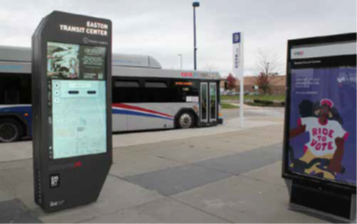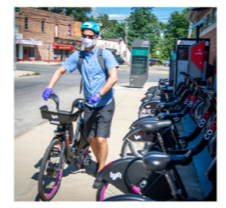The Deployment of the Smart Mobility Hubs in Columbus, Ohio Offered Lessons on Providing First-/Last-mile Solutions for Transit System Connectivity in Underserved Areas.
Columbus, Ohio, United States
Primarily funded by the USDOT’s Smart City Challenge, the Smart Columbus Program is a collection of eight transportation, mobility and data studies aimed at improving access to jobs, enhancing tourism, stimulating the economy, connecting residents to safe and reliable transportation, and supporting efficient and sustainable movement of people and goods throughout Columbus. The Smart Mobility Hubs (SMH) study was established to increase access to transportation in areas with limited transit connection. Specifically, the Linden neighborhood of Columbus was chosen due to socio-economic factors such as being an area of low-income, a void of major employers, and a high infant mortality rate. Therefore, six SMHs were deployed to consolidate transportation services and amenities to allow for intermodal hubs that provide comprehensive transit options and first mile/last mile connections. Furthermore, these hubs were equipped with other deployed services in the Smart Columbus project, such as the Multimodal Trip Planning Application (MMTPA). The hubs were deployed in March 2020, and the deployment lasted one year through March 2021. Performance evaluation and assessment was performed beginning July 2020 and continued through the publishing of the study report.

The lessons learned from the deployment of the SMHs are summarized primarily from public and stakeholder feedback and input. Stakeholder groups and residents were engaged to determine design elements of the SMHs, and their feedback was central to project evaluation.
- Maintain a high level and quality of communication amongst all stakeholders. One of the most critical components of the SMHs deployment was community education to understand the new transit options and tools provided, and how those additions would benefit the community.
- Select kiosk locations with high foot traffic. While indoor SMHs are slimmer and more inexpensive due to the absence of heating and cooling elements, they may also see less activity. For the Smart Columbus deployment, the Linden Transit Center SMH had the most activity and St. Stephen’s Community House SMH had the least amount of activity. Due to COVID-19, St. Stephen’s had reduced programming, limited guests in the building, and was closed to visitors for some time during the demonstration period. Because the kiosk was located inside the building, interactions with the kiosk were drastically limited.
- Accommodate new and emerging technologies with flexible deployment plans. Many emerging technologies, such as e-scooters, e-bikes, and car-sharing may enter and leave the market quickly, meaning that vendors may leave the project with little to no notice. Accommodating emerging transportation modes requires flexibility during the project development and design process and accounting for plan changes as final locations, permitting, and power access may also change and affect the implementation of these technologies.
- Clearly define terms and the anticipated benefits of a deployment to stakeholders. Ensuring stakeholder participation in the deployment requires the partner to understand how the project will square with their overall business model. Providers need to understand the parties they are entering an agreement with and what the final agreement may entail.
- Maintain a high level and quality of communication amongst all stakeholders. One of the most critical components of the SMHs deployment was community education to understand the new transit options and tools provided, and how those additions would benefit the community.

